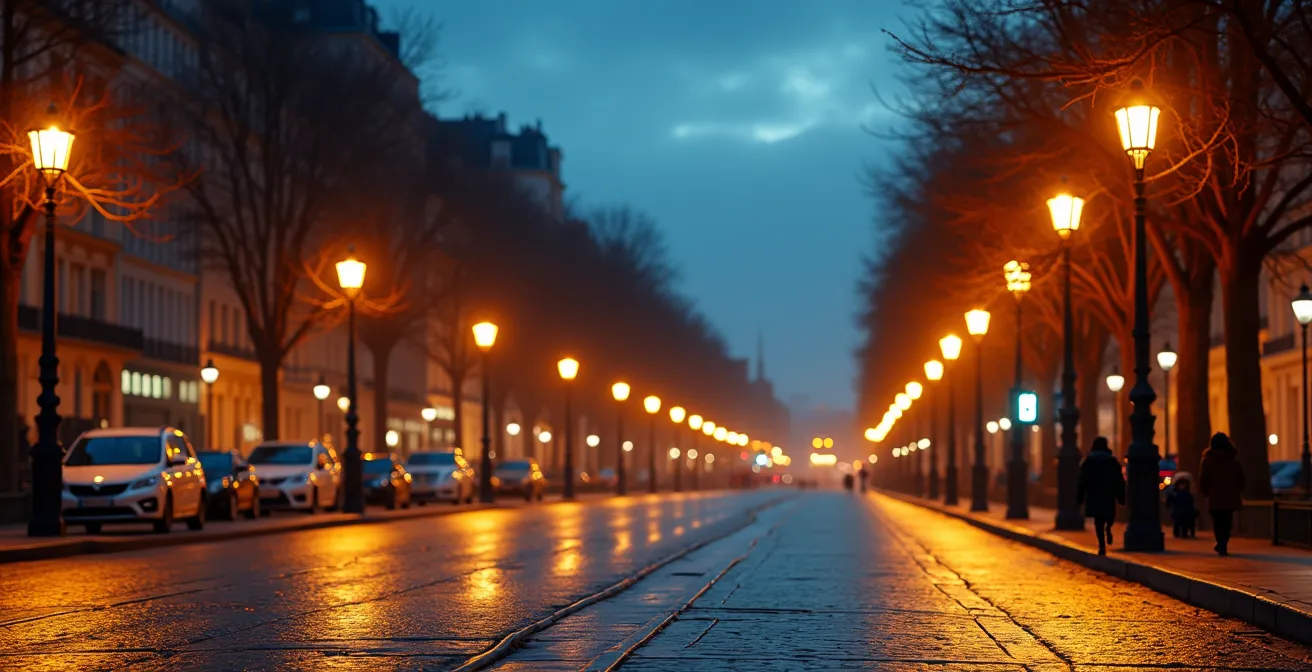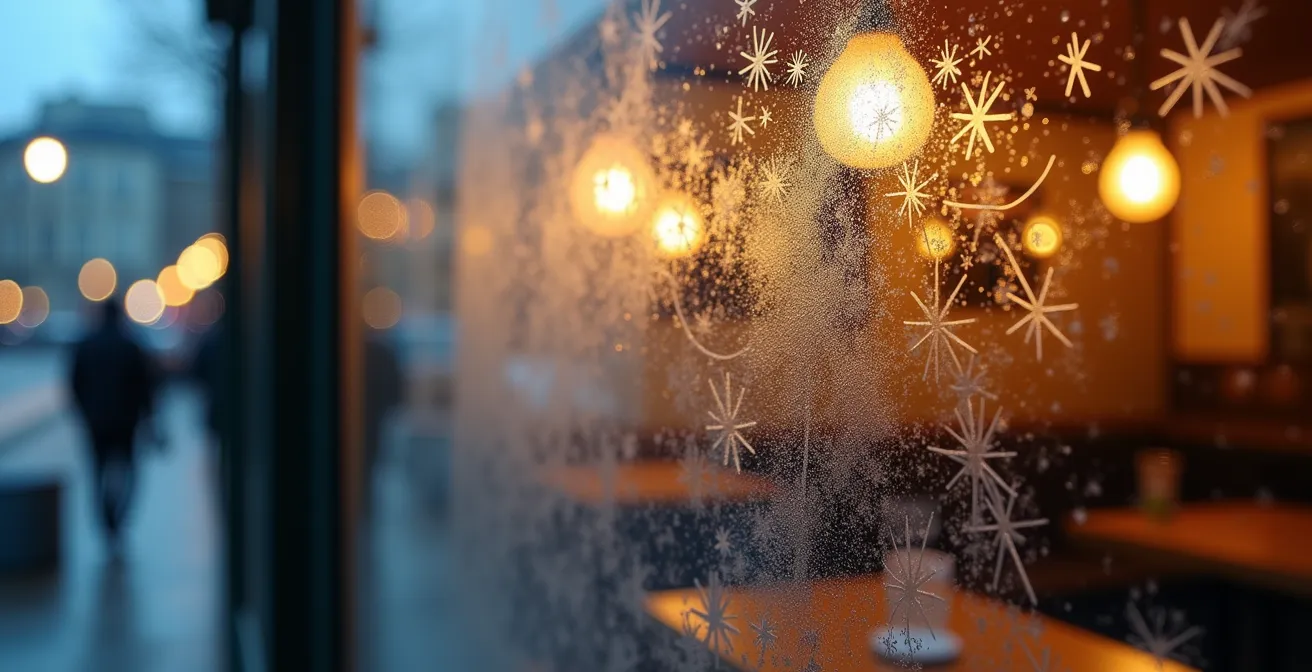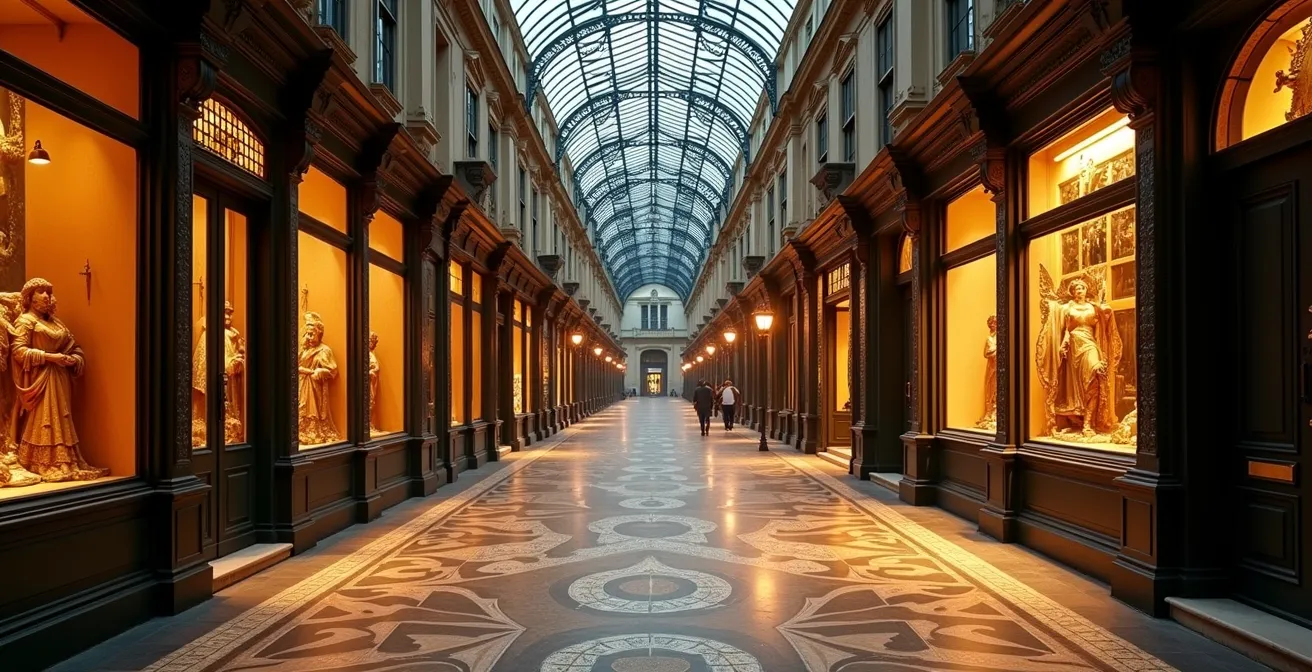
Paris in December defies the standard holiday destination playbook. While countless cities drape themselves in festive lights and open seasonal markets, something fundamentally different happens in the French capital when winter darkness descends at half past four in the afternoon.
The transformation isn’t merely decorative. Beyond the surface narrative of Christmas charm lies a complex interplay of urban design, sensory psychology, and temporal dynamics that rewires how visitors experience the city. Understanding these mechanisms—rather than simply observing their effects—reveals why December nights in Paris create unusually immersive experiences that linger in memory long after guided evening tours through illuminated streets have ended.
This isn’t about compiling another checklist of Christmas markets and light displays. Instead, we’re deconstructing the precise architectural, physiological, and psychological elements that distinguish a December Parisian night from any other seasonal urban experience—examining why darkness itself becomes the city’s most powerful design tool.
Paris December Nights: The Essential Framework
December transforms Paris through three interconnected mechanisms most travel content overlooks. The city’s 4:30 PM sunset creates over 15 hours of nocturnal experience, fundamentally altering visual rhythms from architectural grandeur to light choreography. This extended darkness activates a complete sensory ecosystem—acoustic, thermal, and olfactory—while the five-week temporal window triggers scarcity psychology that intensifies present-moment attention.
- Urban design accidentally optimized for theatrical illumination creates “light corridors” along Haussmann boulevards
- Multisensory contrasts (cold air amplifying sound, thermal transitions, olfactory layering) engage all senses beyond sight
- Hidden nocturnal rhythms in residential neighborhoods and covered passages offer authentic experiences outside tourist circuits
- Strategic timing and movement patterns shift visitors from passive observation to embodied participation
When Darkness Becomes Paris’s Most Powerful Design Element
The transformation begins with a simple astronomical fact that most December tourism content mentions but few truly examine. Paris experiences only 8.4 hours of daylight in December, with sunset arriving by 4:55 PM on the shortest days. This creates something remarkable: over 15 consecutive hours of illuminated darkness that fundamentally restructures the city’s visual and experiential rhythm.
Summer Paris operates on architectural grandeur—honey-colored stone facades, sweeping Haussmannian perspectives, the Seine reflecting blue sky. Winter Paris inverts this completely. By mid-afternoon, the city shifts from a study in classical proportion to a theater of light and shadow where artificial illumination becomes the primary visual language.
Sunset Timing and Tourist Behavior Patterns
Research examining visitor patterns reveals how winter sunset times around 4 PM fundamentally transform tourist experiences compared to 10 PM summer sunsets. The early darkness compresses daytime sightseeing into shortened windows while expanding evening activities into the dominant experience mode. Visitors must recalibrate their entire daily rhythm, often discovering that “night” activities in December can begin while afternoon tea is still being served.
This extended darkness triggers specific physiological responses absent during summer visits. The human body interprets warm artificial light against winter darkness differently than the same lighting in summer twilight. The contrast activates neurological pathways associated with shelter-seeking, intimacy, and heightened sensory attention—evolutionary responses to darkness that modern summer tourism rarely engages.
| Season | Sunrise | Sunset | Daylight Hours |
|---|---|---|---|
| December 22nd | 8:40 AM | 4:55 PM | 8 hours |
| June 20th | 5:45 AM | 10:00 PM | 16 hours |
The genius—entirely accidental—lies in how Baron Haussmann’s 19th-century urban redesign created the perfect infrastructure for nocturnal illumination. His wide boulevards with uniform building heights function as light corridors, channeling and amplifying the theatrical impact of festive installations in ways narrow medieval streets never could. The Champs-Élysées becomes less a street and more a perspective drawing in light.
Even the building materials contribute. Paris’s characteristic honey-colored limestone creates a warm base tone that modern LED technology plays against, generating a temporal tension that feels simultaneously timeless and contemporary. The architecture provides historical weight while the illumination insists on present-moment novelty.
The Sensory Architecture That Rewires Your Winter Experience
Visual spectacle dominates most December Paris content, but the transformation operates across all sensory channels simultaneously. The same cold air that necessitates warm coats fundamentally alters acoustic properties, scent diffusion, and thermal perception in ways that create a complete sensory ecosystem.
The acoustic transformation proves particularly striking. Cold December air changes how sound travels—certain frequencies amplify while others dampen, creating what acousticians call “intimate sound pockets” around café terraces and market stalls. Conversations feel closer, footsteps on cobblestones sharper, church bells clearer across greater distances. Potential snow reverses this, creating sound-dampening that makes even crowded spaces feel hushed and contemplative.
The thermal dimension functions as intentional experience design, though few visitors consciously recognize it. The deliberate movement from cold streets into warm indoor spaces—heated churches, bustling cafés, the covered passages—creates emotional peaks that neuroscience research links to enhanced memory encoding. Each threshold crossing registers as a distinct event marker in autobiographical memory formation.

These thermal contrasts aren’t incidental comfort factors but core components of the December Paris experience architecture. The body remembers the relief of crossing from bitter wind into a warm boulangerie, the steam rising from vin chaud against cold air, the radiant heat of café interiors visible through frosted windows. These aren’t just pleasant moments—they’re the sensory anchors around which December memories organize themselves.
Olfactory layering adds another dimension entirely. The scent profile of December Paris differs fundamentally from other months through a combination of seasonal additions and subtractions. Roasted chestnuts, mulled wine spices, and fresh pine from market stalls layer over the city’s base notes. Simultaneously, air molecules slow down in cold temperatures, meaning aromas don’t travel as far as in warm weather, creating concentrated scent zones rather than diffuse backgrounds.
The physical experience of cold weather paradoxically creates psychological presence. The need to walk faster to stay warm compels movement, yet the sensory richness of each warm refuge forces you to slow down and attend to details once inside. This rhythm of movement and pause, exposure and shelter, creates what cognitive scientists call “environmental forcing functions”—external conditions that shape attention and memory formation independent of conscious intention.
Hidden Nocturnal Rhythms Beyond the Illuminated Boulevards
The tourist narrative of December Paris concentrates on a predictable circuit: Champs-Élysées lights, major department store windows, prominent Christmas markets. This circuit exists and delivers genuine spectacle, but running parallel to it is an entirely different nocturnal city that reveals itself only to those who understand its temporal rhythms and spatial logic.
The “second shift” of Parisian evening life begins around 7 PM, after most tour groups have returned to hotels but before locals conclude their evenings. Paris saw 35% growth in rentals in December 2024, yet this surge concentrates in predictable tourist zones, leaving residential neighborhood squares—Place des Vosges, Place Dauphine, Place Sainte-Marthe—to local families taking post-dinner walks.
These neighborhood rhythms operate on different temporal logic than tourist attractions. Independent bookshops in Le Marais and Saint-Germain stay open late, transforming into miniature cultural salons with their own festive intimacy that organized tours never penetrate. Small galleries host evening vernissages, neighborhood wine bars fill with regulars, bakeries sell tomorrow’s croissants to locals who know the schedules.
Discovering Authentic Evening Paris
- Explore Montmartre’s cobblestone streets lined with lights leading to Sacré-Cœur
- Visit the quieter Christmas market in Montmartre from November 22 to December 29
- Experience the intimate atmosphere of local neighborhood squares after tour groups return to hotels around 7 PM
- Discover independent bookshops and galleries creating their own festive intimacy outside organized tour circuits
The covered passages deserve particular attention as they represent a uniquely Parisian spatial typology that December transforms completely. Passage des Panoramas, Galerie Vivienne, Passage Jouffroy—these 19th-century glass-roofed shopping arcades function as theatrical winter refuges with their own microclimates and preserved historical atmospheres. They’re neither fully interior nor exterior, creating liminal spaces where December’s thermal contrasts play out over distances of mere meters.

Inside these passages, vintage lamps cast warm pools of light on mosaic floors, shop windows display artisan goods with unhurried elegance, and the glass ceilings trap just enough warmth to make coats feel unnecessary. They exist outside the December tourism industrial complex while remaining quintessentially Parisian winter experiences—spaces locals actually use rather than merely tourist attractions styled to appear authentic.
| Location | 6-7 PM | After 8 PM | December Character |
|---|---|---|---|
| Champs-Élysées | Very Crowded | Moderate | High numbers for holiday events |
| Le Marais | Busy | Local atmosphere | Independent cultural spaces |
| Montmartre | Tour groups | Quieter local feel | Residential charm |
Sacred music concerts in churches—Sainte-Chapelle, Saint-Sulpice, Saint-Germain-des-Prés—create contemplative pauses within tourist chaos. These aren’t Christmas-specific performances but regular evening concerts that December darkness makes particularly powerful. Centuries-old stone architecture, candlelight, and exceptional acoustics combine in ways that feel less like entertainment and more like accessing a parallel temporal dimension where Paris exists outside modern tourism entirely. For those seeking French holiday rentals that provide extended access to these rhythms, understanding the distinction between tourist time and local time becomes essential to the December experience.
Why Temporal Scarcity Amplifies Every December Moment
A permanent museum can be visited any month. A year-round restaurant will serve the same menu in July and January. But December in Paris operates under fundamentally different temporal logic—a five-week window from early December to early January creates psychological conditions that permanent attractions physiologically cannot replicate.
People are more motivated to take action when they believe a resource is limited. Limited-time offers leverage this bias, making users feel they might miss out on something valuable.
– Robert Cialdini, FlareLane Blog on Behavioral Psychology
This scarcity principle operates unconsciously but powerfully. When illuminations exist only five weeks annually, attention intensifies in ways that year-round attractions cannot command. The psychological phenomenon known as FOMO (fear of missing out) transforms casual interest into urgent present-moment engagement. You cannot postpone a December night in Paris to next week if you’re leaving the city tomorrow.
The economic impact reflects this intensity. France generated record €71 billion in tourism revenue in 2024, with December representing a disproportionate concentration driven by events like the Olympics and Notre-Dame’s reopening, but sustained by the annual December phenomenon that predates and will outlast any single year’s special events.
The dual countdown structure creates narrative urgency absent in open-ended summer tourism. December builds toward Christmas Day, then immediately pivots to New Year’s Eve—two temporal anchors that create an emotional arc different from “I’ll visit Paris sometime in June.” The calendar itself becomes part of the experience architecture, with each passing day shifting the character of streets and markets.
| Experience | Duration | Scarcity Factor |
|---|---|---|
| Champs-Élysées Lights | November 24 – Early January | 5-week window |
| Christmas Markets | 4-5 weeks | Annual variation |
| Department Store Windows | 6 weeks | Unique yearly themes |
Perhaps most significantly, Parisians themselves experience their city differently during this brief window, creating an authentic parallel transformation that tourists can access. Local bakeries offer seasonal specialties, neighborhood associations organize lighting displays, families make annual traditions of specific markets or skating rinks. This isn’t performance for tourists but genuine cultural practice that visitors can witness and participate in—but only during these five weeks.
The annual change prevents psychological habituation. Even repeat visitors encounter something new because installations evolve yearly. The brain cannot habituate to stimuli that exist briefly and change constantly, maintaining novelty and attention engagement that permanent attractions struggle to sustain. This creates the paradox where a temporary Christmas market can feel more memorable than the Louvre precisely because its temporariness forces complete presence.
Shifting from Tourist Observation to Lived Transformation
Understanding the mechanisms behind December Paris’s power means little without strategic implementation. The difference between external observation and embodied transformation lies not in what you see but how you structure your engagement with the experience itself.
Timing strategy creates the foundation. Peak tourist crowds concentrate in the two weeks surrounding Christmas Day, but the installations and atmosphere extend significantly beyond this window. Arriving during shoulder periods—late November before official markets open, or the “between period” of December 26-31—provides access to the same visual and sensory environment with dramatically reduced crowds, allowing locals to reclaim spaces from peak tourist concentrations.
Strategic Approaches for Authentic December Paris Experience
- Arrive during shoulder periods like late November before official markets open for crowds-free access
- Use Christmas Day when Metro runs extended holiday hours for unique access to normally crowded locations
- Start evenings in residential neighborhoods then gradually move toward center, reversing typical tourist flow
- Commit minimum 90 minutes to single neighborhoods rather than rushing between checklist attractions
- Visit during festive season for that extra layer of transformation unique to December nights
Movement pattern reversal proves equally critical. Standard tourist flow moves from accommodation (typically central arrondissements) outward to attractions, with everyone moving in the same directional patterns. Reversing this—beginning evenings in residential neighborhoods like Montmartre, Belleville, or Batignolles and gradually moving toward the center—creates the opposite sensory journey: from authentic neighborhood atmosphere toward spectacle rather than vice versa.
This reversal matters because it changes the psychological framing. Starting with intimate neighborhood squares and local cafés establishes a baseline of authentic Parisian rhythm before encountering tourist-focused installations. The grand boulevards and major markets then register as heightened moments within a broader urban experience rather than the entire experience itself. Those considering romantic French getaways will find this approach particularly effective for creating memorable evening experiences.
Duration commitment separates superficial exposure from genuine immersion. The contemporary tourist impulse—checklist-hopping between maximum locations in minimum time—fundamentally conflicts with how sensory adaptation and spatial discovery actually function. Committing minimum 90 minutes to single neighborhoods allows time for the initial novelty to fade and secondary layers to reveal themselves.
What appears ordinary in the first 20 minutes—a neighborhood café, a residential square, a small market—develops complexity and character over extended exposure. Regulars arrive and leave, light quality shifts as evening deepens, details invisible during rushed observation emerge through sustained attention. This temporal commitment transforms spaces from backdrops for photos into environments you actually inhabit.
Documentation restraint represents perhaps the most counterintuitive strategic approach. December Paris’s low-light conditions produce mediocre smartphone photos that require significant effort for marginal results. The constant attempt to capture experiences through inadequate technology demonstrably reduces embodied presence and memory formation.
The paradox: photographing less often correlates with remembering more. Without the mediating screen, sensory input encodes more deeply. The brain processes lived experience differently than documented experience, and in low-light evening conditions where photographic quality suffers anyway, the tradeoff increasingly favors direct perception over mediated capture.
Key Takeaways
- December’s 4:30 PM sunset creates 15+ hours of illuminated darkness that fundamentally transforms Paris’s visual rhythm
- Multisensory architecture—acoustic, thermal, olfactory—engages all senses beyond the purely visual Christmas lights narrative
- Hidden nocturnal rhythms in residential neighborhoods and covered passages offer authentic experiences outside tourist circuits
- Temporal scarcity of the 5-week December window triggers psychological urgency that permanent attractions cannot replicate
- Strategic timing, movement reversal, and duration commitment shift visitors from passive observation to embodied transformation
Frequently Asked Questions about Paris Christmas Tourism
What makes December nights in Paris different from other winter cities?
The combination of early sunset creating extended illuminated darkness, Haussmann’s boulevard architecture functioning as light corridors, and the temporal scarcity of 5-week installations creates unique conditions. Unlike cities with later sunsets or different urban layouts, Paris’s specific astronomical timing and 19th-century urban design accidentally optimize for theatrical nocturnal experiences that engage multiple sensory channels simultaneously.
When is the best time to visit Paris in December to avoid crowds?
Late November before official Christmas markets open, or the period between December 26-31, offer significantly reduced tourist concentrations while maintaining the same festive atmosphere and illuminations. Christmas Day itself sees many locals leave the city, creating unusual access to normally crowded locations, with extended Metro hours facilitating movement.
How does the sensory experience of December Paris differ from summer visits?
Cold air fundamentally alters acoustic properties, scent diffusion, and thermal perception. Sound travels differently creating intimate pockets around cafés, aromas concentrate rather than diffuse, and the deliberate movement between cold streets and warm interiors creates emotional peaks that enhance memory encoding. The 8-hour daylight window versus 16 hours in summer completely restructures visual rhythms from architectural to illuminated experiences.
What are the hidden locations tourists typically miss during December in Paris?
Covered passages like Galerie Vivienne and Passage des Panoramas transform into theatrical winter refuges with preserved 19th-century atmospheres. Residential neighborhood squares in Montmartre, Le Marais, and Belleville reveal authentic local life after 7 PM when tour groups depart. Evening sacred music concerts in smaller churches offer contemplative experiences outside the standard tourist circuit, while independent bookshops and galleries create intimate cultural spaces with their own festive character.